Everyone dreams of that once-in-a-lifetime experience or of acquiring that once-in-a-lifetime possession. To obtain that, to walk in the footsteps of a Legend, is a story worth sharing.
Peering Through an Historical Lens:
John Moses Browning had a vision; build a shotgun with tubes superimposed one over the other and introduce it to the world for less money and “affordable to every man”. It was to be his final design, and one of his many brilliant firearms that changed the sporting gun market for the rest of time. Unfortunately, his death on November 26, 1926, preceded its completion. His son Val sailed for Europe and immediately took control of the project, but not without challenges.
Prominent American companies had rejected his previous offers, so he took the manufacturing plans to Fabrique Nationale in Belgium, granting them full production rights under a royalty agreement. In 1931, Browning advertised to the public their new Overunder (Superposed) shotgun with double triggers. (John Browning really wanted this shotgun to have a single, selective trigger to distinguish it from the more common designs in England and Europe, however, it was to be his son Val who eventually perfected it and released this updated version in 1939).
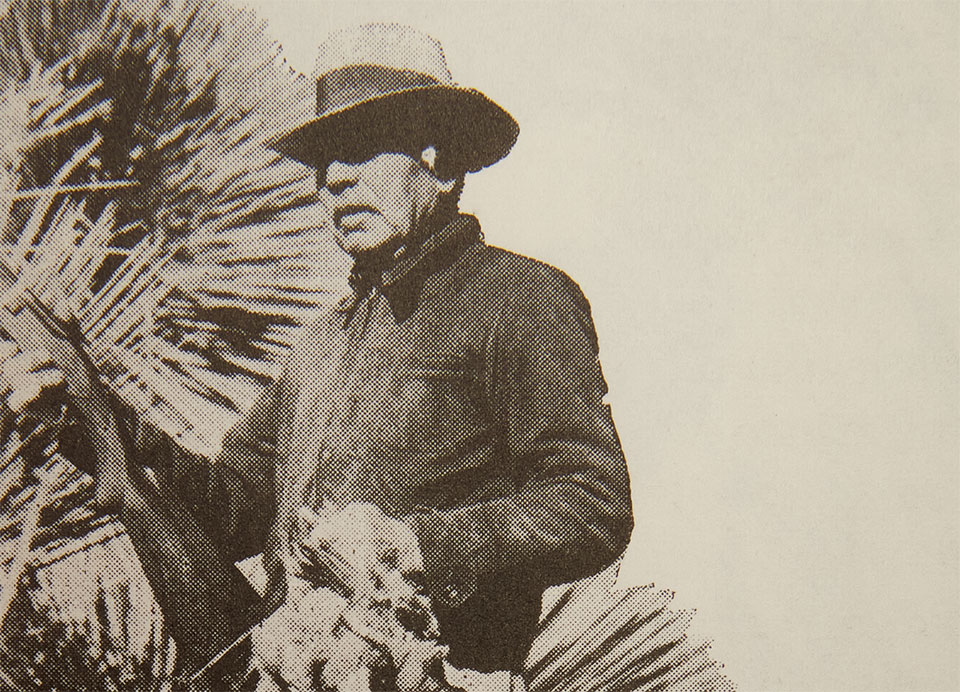
Unveiling a new product during the Great Depression proved to be quite a challenge for Browning. Early sales were slow, so poor in fact that data reflects that possibly only a handful of Superposed were built and sold in 1933. Due to the lack of sales, Browning dropped the retail price on its Standard grade gun from $107.50 to $99.50 in 1934. To further promote sales another price drop followed in 1935, to $69.75. In 1936, the price increased to $79.80 where it would stay through the next three years.
By the time World War II broke out in 1939, Browning had sold roughly 17,000 guns. Further research reflects that Superposed production ceased with serial numbers in the 17020 - 17030 range, with production resuming in the 17100 range sometime in 1948.
A cursory review of the 1931 Browning Superposed catalog and order blank shows that the following details and options were available:
Grades and Introductory Prices: (Standard $107.50, Pigeon $175.00, Diana $277.00, and Midas $374.00).
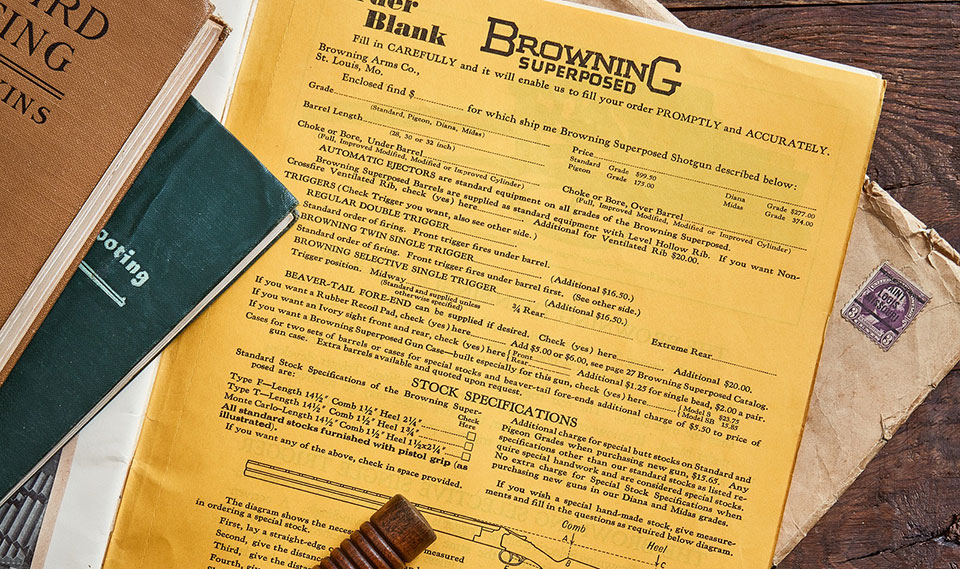
Barrel Length’s (28”, 30” or 32”). Choke (upper barrel) – Choke (lower barrel).
Barrels supplied with level hollow rib. If you want Non-crossfire ventilated rib check (yes) here. Add $20 for ventilated rib.
Grip styles available: (1) Straight grip. (2) Half pistol grip. (3) Full pistol grip. (Specify the style you want).
Special stocks available at $15.65 extra.
Upgraded select wood from $35 to $75.
Beavertail forend. Add $20.
Rubber recoil pad. Add $5 and $6.
Ivory sight front and rear. Add $1.25.
Model “SB” gun case. Add $15.85.
Model “S” gun case. Add $23.75.
Early order forms state “At least $10 must accompany order. The balance can be paid to Postman or Expressman when gun is delivered. We desire to serve you correctly and promptly. If you have any special instructions or requests, use the other side of this sheet”. In addition, Browning announced a new sales policy “Direct-from-Browning-to-You”.
This new policy offered any Superposed of the customer’s choice a money back, two-day inspection of the gun. By going direct to Browning Dealers, they cut out the distributors (which was the common practice at this time) basically giving the customer a 25% discount. Browning also maintained a list of Authorized Service Stations, to service their products, covering the country east to west.
“Lightweight” Superposed Standard grade:
According to Dr. Robert Rush of Louisiana, “I acquired Browning Superposed #5323C in the fall of 2007, when I noticed it on Collector’s Firearms of Houston, Texas website. I proposed a trade, over the phone and sight-unseen against a Miroku built Sporting Clays gun ‘even up’ and the salesperson cordially accepted. Little did I know at the time that the gun I walked out with was to be anything out-of-the-ordinary. A few weeks later I posted some notes about my recently purchased firearm on a prominent Internet site, forum members suggested I should get a factory letter from the historical department at Browning Arms Company in Utah”.
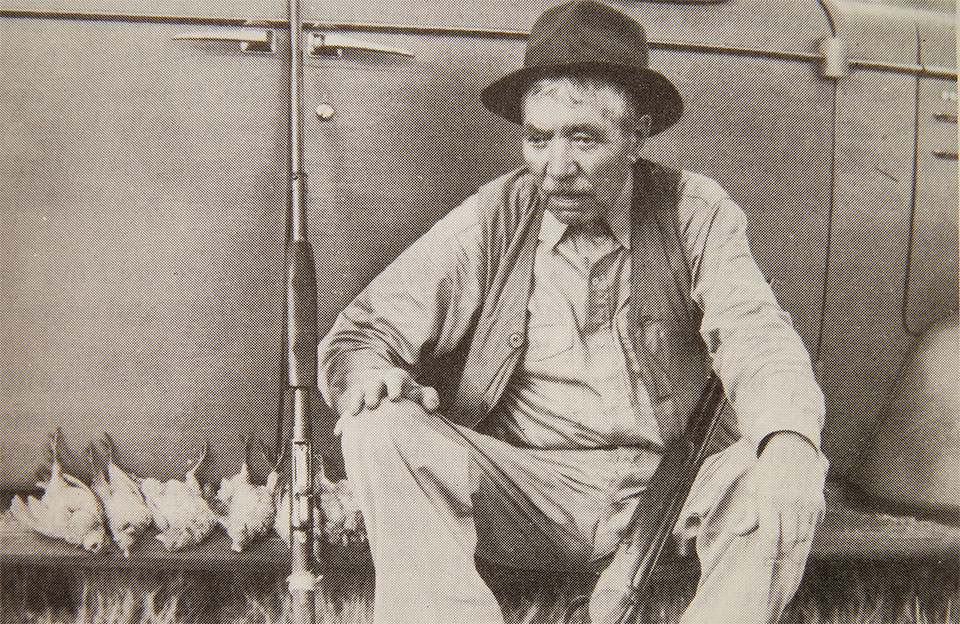
Mr. Glen H. Jensen, the Browning U.S.A. historian, asked him “Sir, do you have any idea who once owned this gun”? The excitement in his voice immediately told Dr. Rush that this might be something special. Glen inquired how this gun had ended up in his possession, then proceeded to outline its provenance; “Shipped from Browning directly to Capt. Charles Askins, Ames, OK, July 23, 1932, at a cost of $107.50”. The original invoice states “Single selective trigger installed in the rear position $30.00, Hawkins recoil pad $5.00, plus an additional $2.00 charge for an ivory front sight”. Two years later a work order gives the description of the gun and the directions “Fit longer firing pin for lower barrel and check over action”, no charge.
A final work order dated July 3, 1935 reads “Put gun in first class working order and test thoroughly”, once again no charge. Nowhere amongst all these invoices and documents does it state anything concerning the European sculptured A1 engraving pattern. Americans favored the flat-sided receiver, whereas Europeans preferred the sculptured receiver. Major Askins (Capt. at the time) endorsement of the “Superposed” as Shotgun Editor of American Rifleman and Field Editor of Outdoor Life was a huge boost for Browning. When this order came in, the Browning company obviously treated him right, and hand selected upgraded wood was simply the proper thing to do.
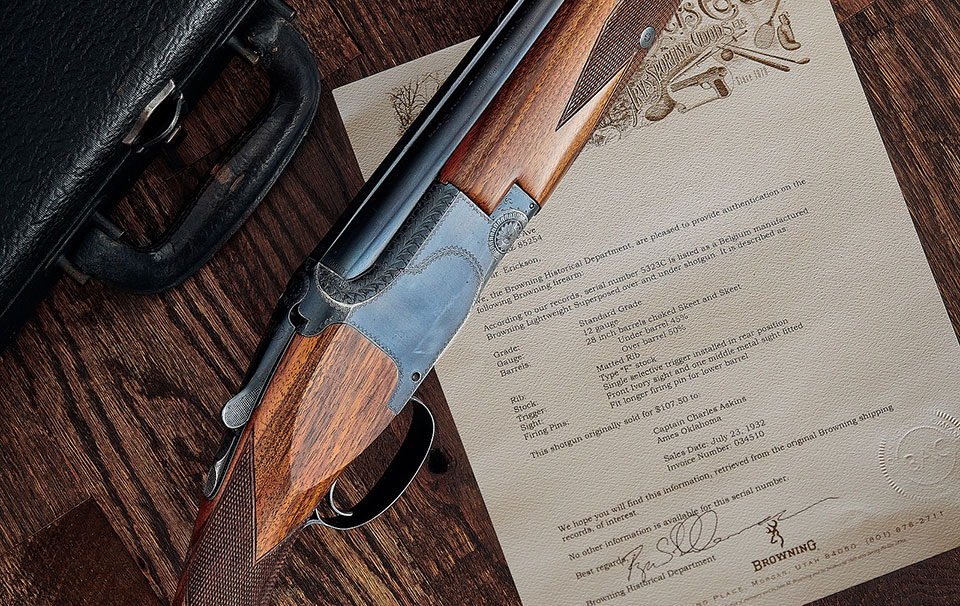
Major Askins was considered by most as the leading authority on bird shooting and shotguns both before and after World War I. His ability to pen that information into articles became his life’s work. His first book The American Shotgun (1910), was followed by Wing and Trap Shooting (1911), and Rifles and Rifle Shooting (1912). Around 1898, this writing career lasted nearly sixty years.
Major Askins lived during a different era; a time when there were no game wardens monitoring bag limits, a time when the hunting seasons were simply “when the birds were flying”, a time when the country longed for practical advice on shooting. Having the unique opportunity to hone his skills over long periods allowed him to study the art of wing-shooting using various techniques.
He was in the position to be able to handle various styles of guns, study ballistics, shot patterns, and ammunition produced by the major manufacturers of the day. His ability to pen that information into articles was his life’s work. He was also considered by most as the leading authority on bird shooting and shotguns both before and after World War I. His first book The American Shotgun (1910), was followed by Wing and Trap Shooting (1911), and Rifles and Rifle Shooting (1912). His writing career lasted nearly sixty years.
Passage of Time:
The Major’s grandson William Askins, a Marine Officer, Aviator, and veteran of Vietnam, who went on to spend many years overseas with the Central Intelligence Agency, now retired, detailed a portion of his family history and his grandfather’s life:
“The Askins family were lowland Scots and were part of a British mandate in 1649 to relocate native Scots to Northern Ireland to repopulate that land, devastated by war during the first half of the century. The Askins stayed in Ireland only thru a generation or two before immigrating to America to escape British rule.
Askins was among one of the first settlers in Belleville
Edward Askins landed in Virginia in 1700 and the family eventually owned land now occupied by the Quantico Marine Corps base. Like many early families, successive generations moved west. In 1825, Charles Tankersley Askins was among one of the first settlers in Belleville, IL, a farmer who bred thoroughbred horses, without a lot of financial success.
The young Askins (Major), born in Illinois, broke horses, worked cows, and soon developed a fondness for animals. The young man was exposed to the wonderful hunting along the Illinois River and the New Madrid marshes of Arkansas. He hunted wild game but couldn’t bring himself to shoot anything around the farm: chickens, pigs, or cattle. He advised others not to raise pigs, as they always become pets and then must be killed.
At a young age he became a lawyer by profession, but soon tired of the courtroom fanatics, and turned to his real passion, the great outdoors and baseball. When his father died, he began teaching during the winter months and played baseball during the summers. On the road to becoming a professional ballplayer, an injury to his throwing arm ended that career.
He found that his soul was in the hunt, a market hunter, a bird dog trainer, and a field trial judge. The one thing that kept him from being a top dog man was his even greater enjoyment of shooting. He left Illinois, continued training bird dogs, and reportedly hunted in every state in the South except Louisiana and South Carolina. Around 1893, he vowed to break the record made some years earlier by Hiram Stotlar, a market hunter, of 72 quail in one day. He fell short by 11 birds, however, there was one run of 23 straight!
The Spanish-American War of 1898 abruptly derailed his writing career. He found that he genuinely enjoyed the military life, the thrill of bullets flying, and the companionship of his comrades. He remained on active duty after the conclusion of hostilities in December 1898 and was then posted to the Philippines, serving in the Muslim South Islands as a cavalry officer during the Moro Rebellion. He liked the military but was seriously wounded, and was then sent to Fort Niobrara, near Valentine, Nebraska to recover from Malaria and the serious bolo knife wound he suffered while fighting the Moros.
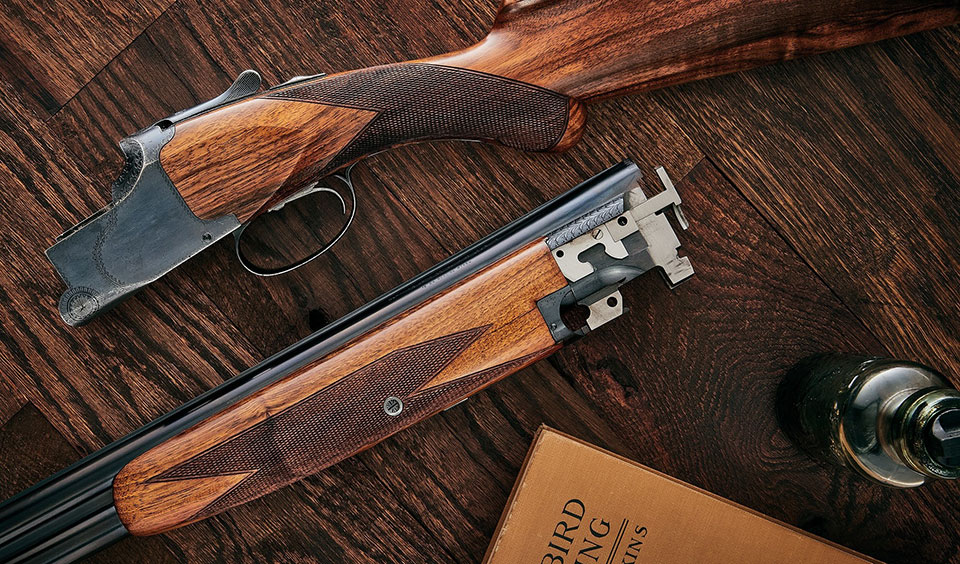
The Army sent recovering malaria victims to cool duty stations rather than the hospital south, the idea being that hot weather would reignite the malaria. In 1907, his son “Charles Jr.” (the Colonel) was born while the family was living at Fort Niobrara. (As a sidenote, the Major shot the Moro repeatedly with his issued .38 and the guy kept coming, which made a profound impression on him regarding the need for a heavier pistol caliber, thus he promoted the adoption of the .45 as the standard government service cartridge).
After recovery, he was medically retired but eventually returned to active duty during World War I. During this time, he served as an Advanced Marksmanship Instructor, he did not get to go to France so stayed in the States, travelling around with other top shooters giving classes at various posts.
He knew everybody of any note in the guns and hunting community, along with several conservationists and politicians. The country was a lot smaller in those days and there was a greater interest and acceptance of small arms than there is today, so he played a considerable role across the sport and hunting in general, reaching many people in his prolific and lengthy writing career.
My father was thick as thieves with the elder Brownings...
“The Askins, the Olins, and the Brownings of those two generations were all good friends and colleagues in the gun world. In fact, Val Browning visited my father, the Colonel, when we were living in Madrid from '49 to '53, he was an Army Attaché attached to the Embassy, and then in the Military Aid Mission that started the rearming of the Spanish Army. My father was thick as thieves with the elder Brownings, as he was with the Olins, who grew up across the river from Belleville in St. Louis. All the Olins visited as well, and when I returned to the USA for school by myself, they arranged a two-week sail on the schooner Brilliant out of Mystic Seaport, and then flew me on the company plane to St. Louis, heady stuff for an 11-year-old kid! I just presumed that was the way that life was lived, it was not until later that I looked back on the whole episode as something out of the ordinary.
The Olins were a little concerned, as was Ed Pugsley, who was the President of Winchester at the time, and a major figure in the firearms industry, with a kid of my age traveling by himself around the world, so they all undertook making sure I got where I was supposed to go. The aircraft was a plushed-up DC-3, which went from Hartford to St Louis, where some of the Olin family took me in tow to their house where I spent the night, and then put me on a commercial flight to Oklahoma City where I was met by my aunt and uncle”.
When asked of William Askins if he had any personal memories to share of his grandfather, his reply was: "Yes, I remember him as a craggy old man, but happy, always playing with me. He was the first person I crossed swords with. He had learned fencing in the Old Army, and of course, I was in the pirate stage of growing up, so we were in a similar frame of mind." What a wonderfully expressive statement, very descriptive of the old man, and how he and his youthful grandson interacted.
Major Askins eventually moved to the El Paso, Texas area near Ft. Bliss where both him and his son, the Colonel, had homes down the road from each other, not surprisingly only a few miles from where he used to run his dogs and hunt desert quail. Upon his passing in 1948, he was buried at Fort Bliss National Cemetery.
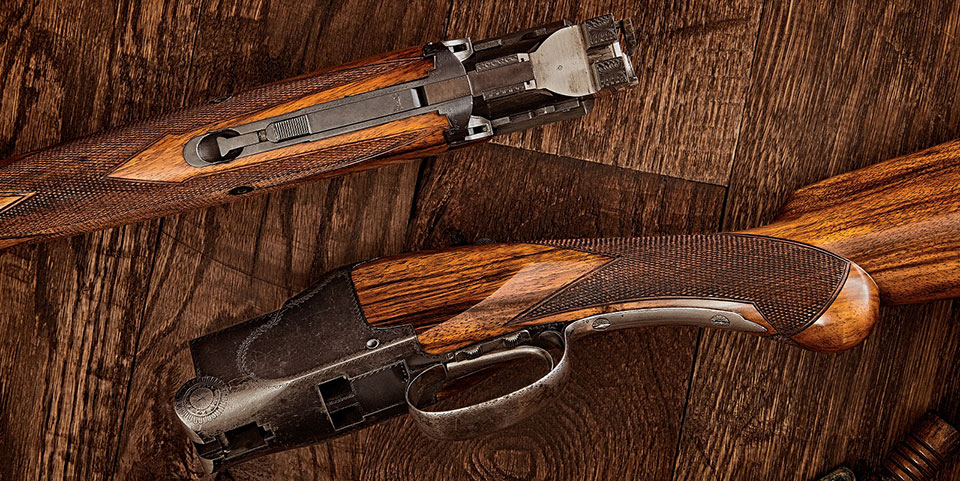
Askins Timeline:
Charles Tankersley Askins (1800 – around 1885).
Major Charles Askins, Sr. (around 1862 – 1948) He fudged his birthdate so he could get in the Army later by cutting approximately ten years off his age.
Colonel Charles Askins, Jr. (1907 – 1999).
Major William Askins (1941 -
Dr. Rush and I became acquainted in October 2021, when I became the newest caretaker of Browning Superposed #5323C, the very gun that Major Charles Askins advocated should be built in his 1929 book, Modern Shotguns and Loads.
The author has visited Fabrique Nationale / Browning in Belgium with the sole purpose of expanding his Superposed knowledge, and is truly honored to be the current custodian of Askins personal quail gun.
NOTES
Dusty Erikson is a private collector from Arizona USA.
This article content would not have been possible without the important historical contributions by the following people: Major William Askins - Retired, Dr. Robert K. Rush, Ms. Jackie Love and Mr. Ryan Skidmore - (Browning Arms Co. - Ogden, Utah, USA).
Publishing rights for all Askins family photographs in this article, and all related text was granted by Major William Askins, San Antonio, Texas.
Published by Vintage Guns Ltd on




